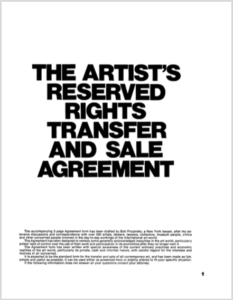
Abstract:
“The Artist’s Reserved Rights Transfer and Sale Agreement” (Siegelaub-Projansky Agreement) of 1971 and the certificates of early Conceptual art have been considered contradictory for enabling so-called “dematerialized” artworks to be exchanged as any other commodifiable work, thus negating Conceptual artists’ claims of challenging market and institutional conventions. However, an expanded lens on the life of the Siegelaub-Projansky Agreement in law yields another legacy for these endeavors, where the Agreement is instead evidenced as influencing artists’ rights laws in the United States, and where its rhetoric of collectivity can be viewed as a radical appropriation of private law in an effort to establish more equitable art industry norms. This reclaimed narrative of political influence emerges only when we recognize the capacity of these artistic documents as legal instruments, and consider how they have circulated through and challenged the limits of both fields they are cross-classified between: art and law.